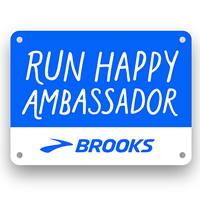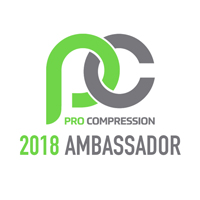I’ll be 100% honest with you… I’m terrible at doing any of this consistently. I’m the “BAD” runner that uses these when there is an issue or I feel really tight. The “SMART” runner would do it consistently and regularly to AVOID having that issue pop up. I feel a lot better when I do it consistently and my running improves because of it… but like I said, consistency seems to be my biggest issue.
But I wanted to take a look at some of the options that are available to athletes looking to roll things out or for a personal massage. As I have stated before, I’m not a coach, nor am I a doctor or physical therapist, so the below review is just my opinion and how it works for me.
Keep Rolling, Rolling, Rolling
Let’s take a look at a couple of options for rolling on the floor… one of our favorite things to do, right?
The typical blue foam roller
I don’t know which brand this is, and there are many on the market. This typical blue foam roller was the first roller that I bought and I think many of us may have started with something like this. I purchased this one around the time that I first started experience IT issues. It was my best friend for a few months and it helped me get through it after many nights of rolling in front of the television late at night. I still use it in combination with the one below.
M80 Roller
I discovered the M80 Roller earlier this year from RunEMZ. She had me try it out and compare it to a couple other options she had and it was a game-changer. A couple of weeks after RnRAZ, I ordered mine. I like a deep, hard roll to work things out — probably because I’m always tight from lack of doing it consistently. This thing is NO JOKE. It is one of the hardest things I have ever rolled on and struggle to last very long without having to take a break, BUT you can feel it working. The term “no pain, no gain” comes into play here. There are also different versions (and customizable colors) available from longer and shorter lengths.
What I typically do is start with the M80 roller and get that deep rolling out-of-the-way, then transition to the blue foam roller for a longer, rolling session. For example, I would roll on the M80 for 5-10 minutes on each side, then roll on the blue one for 15-20 minutes more. I tend to time based on a 30-minute television show. It’s a good (and kind of fun) way to keep track.
Enso Roller by EvoFit
I wanted to bring attention to the Enso roller that has been featured in Runner’s World and several other fitness publications. I have not tried it, but it uses adjustable discs allowing you to focus on an entire area or pinpoint a problem spot. In terms of allowing YOU to adjust to your specific needs, it allows you to adjust up to 8 independent rollers. Something that a roller won’t allow you to do. It definitely opens up the possibilities for those that need something customized to a specific area/muscle group.
They also have a travel version that comes in at only 8-inches and 6 independent discs.
Trigger Point (or similar grid-type roller)
I tried the Trigger Point Roller really quickly. I probably didn’t give it a fair shot to be honest, but after less than a minute, I just wasn’t feeling it — literally. I honestly thought it was going to be a deeper massage and more intense. I actually preferred the firmness of the typical blue one. The grid format is designed for specific targeting of muscles and perhaps I prefer a smooth roll covering the entire muscle. Again, I may have been using it incorrectly, but wanted to include it on this over-all review as I know some runners that swear by it.
Let’s Get Personal
Here are a couple other options that are not rollers. These are versions that you use your hands to apply a personal massage to a particular area.
The Stick
I have the The Stick – Original Body Stick, but there are several other personal massage sticks
on the market. I also used this one around the time I was having IT issues and rotated into my nightly routine. This one was more convenient if there was no room on the floor or if I wanted to get a really quick 5-10 minute massage in before I went to bed. The thing I like about the stick is that the pressure is entirely dependent on you. If you wanted a deep massage in a particular area, go for it. If you were looking for a lighter touch, just ease up. The added benefit about this one is you can travel with it in a backpack and it doesn’t take up much space.
Moji Line
You might not have heard of the Moji line, but if you travel a lot to race, I may have just changed your world. They have several options. The 360 Massager works in the same fashion as the stick, but is lined with, what I’ll describe as, tiny marbles (massage spheres) that roll along the muscles as you apply pressure. You can use it all over your body from your calves, to your ITB, to your neck, so it gives a great range of motion and doesn’t take up too much space. They also have a 360 Foot Massager, which I have not used, but it looks to deliver the same type of massage focused on the foot that can be used while sitting. Plantar Fasciitis relief comes to mind, but like I said, I have not tried it.
The 360 Mini Massager is the one that I think will change how you recover if you race often in other cities. I used this when I did the SA2LV challenge and when you run a half marathon, then jump on a plane to Vegas, this little thing is perfect to use on a plane. It doesn’t take up that much space (slightly longer than an iPhone 5) and allows you to pin-point an area with precision. You know how you have that one tight point on your legs, THAT. This little hand-held massage can allow you to dig deep on a very specific point. Since I tend to hop on a plane the same day after a race, this thing slips into my carry on and allows me to massage things out in my seat.
• • • • •
There you have it. A general look at some of the recovery tools on the market. There is definitely an opportunity for all of us to find out what works best for our personal needs. From simple to personal to adjustable, you just have to find out what works best for you. Perhaps you are like me and use a combination to suit your needs… either way, recovery is definitely something that runners should all be doing, including myself.
What are you currently using?













I use TriggerPoint Therapy. I have a “kit” for low back, hips that works great for ITB, calves, plantar fasciitis, piriformis probs. Also have their Grid. I have a date with these implements of torture after work!
I have the trigger point grid roller and I really like it. But like you, I’m not consistent. Need to get better at that.
I LOVE my M80 Roller! And Stick! And golf balls ;) I actually posted about ROLLING a couple weeks ago – http://cmcdot.blogspot.com/2014/07/foam-rolling.html.
I live on my basic foam roller. I have been thinking of getting the trigger point too. I’m always up for more pain.
oh
I only foam roll.
I NEED ME SOME TRIGGER POINTING…
I just have the basic foam roller. It hurts so good!
I’ve got your basic black (blue) roller. Even though I have my clients use them at the end of each trainings session, I too am inconsistent. I always feel better when I remember to roll.
I’m a bad runner when it comes to rolling. I’ve never owned or really tried an actual roller. *GASP* However, I do own The Stick. Took me a longtime to get used to it and initially hated it. However, I’ve found that it does the trick when I’m real tight. Alas, I still don’t use it as often as I should. Like you said, maybe that’s why it’s so tough to use them….since I’m not used to it =)
I LOVE my 360 massager – now if I could only find it…
Love love love my foam roller! Probably don’t use it as often as I should..
I just learned a bunch! Thank you!
I am SO bad at rolling consistently. I know I should probably spend about 10-15 minutes every night stretching and rolling and I am a complete failure at it :) I just have a standard white roller and a tiger tail stick type thing. I also have one of those calf stretchers. Thanks for the reminder. Maybe I’ll go roll now! xo
I too am bad about remembering to use mine consistently and not just when I am in pain.
All of these look like they hurt so good! I have a rolling stick and a foam roller. I will admit that I am bad at remembering to do it unless I feel like I need it!
This is a great summary, thanks! I am horrible about remembering to foam roll but I do think it’s important.
Oh I have a love/hate with my roller. I have the travel stick and a regular roller. I have severe IT band issues so it gets used a lot (well, not right now, but it will again haha)